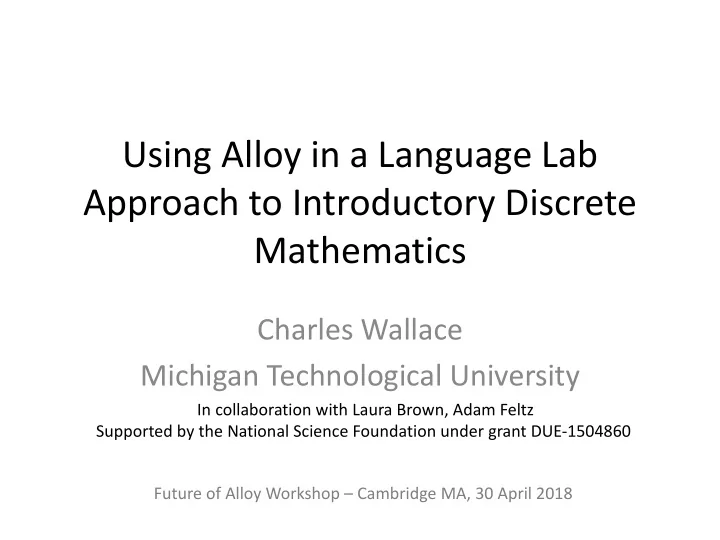

Using Alloy in a Language Lab Approach to Introductory Discrete Mathematics Charles Wallace Michigan Technological University In collaboration with Laura Brown, Adam Feltz Supported by the National Science Foundation under grant DUE-1504860 Future of Alloy Workshop – Cambridge MA, 30 April 2018
Our “standard” Discrete Structures course Too many topics – not enough time A break in the continuum: “all theory, no practice”
Lost in translation • Behind every successful mongoose is a wombat. ( ∀ m )( ∃ w ) mongoose ( m ) ∧ successful ( m ) ⇒ wombat ( w ) ∧ behind ( w , m ) ( ∀ mongoose ) successful ⇒ behind ( wombat , mongoose ) ( ∀ m )( ∃ w ) mongoose ( m ) ∧ successful ( m ) ∧ wombat ( w ) ∧ behind ( w , m ) ( ∀ m )( ∀ w ) mongoose ( m ) ∧ successful ( m ) ⇒ wombat ( w ) ∧ behind ( w , m )
Lost in translation • Without early, repeated feedback, these syntactic and semantic errors can persist. • Traditional “pencil-and-paper” exercises typically delay feedback until it’s too late. • Alloy provides an opportunity for just-in-time feedback on student input – just like in their programming courses.
Scaffolding Alloy • Powerful tool – use with caution! • Ease students into Alloy gradually: – Observing: Students run a complete program and interpret Analyzer output. – Tweaking: Students play with highly constrained parameters of a complete program. – Building: Students complete portions of an incomplete program.
Declarative paradigm rocks their world • Strategies for debugging, testing? • Googling Stack Overflow = FAIL
More scaffolding • Worked examples • Lab assignments, with human support • Alloy cheat sheet • Guided inquiry process • Start with single scenario, then generalize
Example: Study abroad Test predicates, functions in single scenario; then generalize by pulling out constraints
Example: Hipster café lab Every cafe with a bus stop has busses arriving and busses departing; there are no • “dead end” bus stops. Let’s take this one step by step. How would you express the set of cafes that are bus – destinations? Hint: the composition operator . is your friend here: match against any cafe (the set Cafe) on the left hand side. – How about the set of cafes that have bus departures? – What has to be true about the two sets you’ve just defined (departures and destinations)? Let’s assert that every cafe is reachable from every cafe within two “green travel” • steps (walk-walk, walk-bus, bus-walk, bus-bus). – The pairs of cafes that have a one-step green path? That’s easy: it’s just greenTravel. – But how about two-step green paths? Hint: again, the composition operator . is your friend. – Zero-step green paths? I’ll give that to you: it’s the identity relation iden that relates each cafe to itself. Now, how about within two green travel steps? That means zero, one, or two steps. Combine – the sets you’ve defined above. What do we want to say about the pairs of cafes with zero/one/two-step green paths; i.e. – what has to be true of this collection of pairs? We have a predicate for that. Guided inquiry steps point to a problem-solving process (would be interesting to formulate a general process)
Preliminary results • Course with Alloy labs significantly outperformed course without … – but some confounding factors: similarity of assignment/exam questions, student composition across courses • (Cleaner longitudinal study underway)
How does it help? Pathways to better performance: via confidence, motivation, self-efficacy, perceived usefulness
Comments: (26/34) The labs were a great experience. They forced you to sit down and try to solve the problems with a partner while you were there to help. I would say that the labs were easily where I learned the most this semester. The labs were helpful to be able to visualize things . I liked how in the labs you didn't just give us the answers if we didn't understand it. Instead you gave us hints to help us see the answers ourselves. The labs were helpful for understanding what we were learning about in class and applying topics to situations . Having the labs (even though they were frustrating for me), I think helped me understand many of the topics of discrete structures better.
Comments: (5/34) I'm very conflicted about the lab. I'm not sure if it really enforced my learning of the material. Although, the lab with the automata [JFLAP] was incredibly useful and a great learning booster, as it's the exact way you actually implement state- logic type of material. The rest of the labs were more of ``learn how to do the same problems in this strange language '' rather than ``this will bolster your knowledge of the material''.
Ideas for the future • Block-based interface – avoid early syntax struggles • Autograder – feedback for students as they work through problems • Graphical scenario creator – encourage student testing • Repository of worked problems • Process(es) for design, debugging, testing
Publications L.C. Ureel. Discrete Mathematics for Computing Students: • A Programming Oriented Approach with Alloy. FIE 2016. C. Wallace. Learning Discrete Structures Interactively with Alloy. • SIGCSE 2018 Workshop. L.E. Brown, A. Feltz and C. Wallace. Lab Exercises for a Discrete Structures Course: • Exploring Logic and Relational Algebra with Alloy. ITiCSE 2018.
Recommend
More recommend